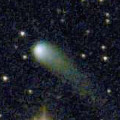
|
Now it is 11.0 mag (Nov. 1, Seiichi Yoshida). It is expected to brighten up to 8 mag in 2020. It stays observable in good condition for a long time in the Northern Hemisphere. In the Southern Hemisphere, it will be getting lower gradually, and it will be unobservable in early December.
Date(TT) R.A. (2000) Decl. Delta r Elong. m1 Best Time(A, h)
Nov. 2 5 35.42 35 41.1 2.078 2.848 132 10.9 2:53 (180, 89)
Nov. 9 5 30.24 38 2.4 1.951 2.782 139 10.7 2:21 (180, 87)
|

|
Now it is 11.5 mag (Nov. 1, Seiichi Yoshida). It stays bright as 11 mag until winter. It stays observable in good condition for a long time in the Northern Hemisphere. In the Southern Hemisphere, it locates low, and it will be unobservable in early December.
Date(TT) R.A. (2000) Decl. Delta r Elong. m1 Best Time(A, h)
Nov. 2 0 40.96 38 10.7 2.248 3.126 146 11.2 21:54 (180, 87)
Nov. 9 0 25.60 38 41.3 2.294 3.125 140 11.3 21:12 (180, 86)
|
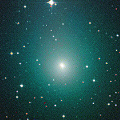
|
It brightened up to 8.3 mag in September (Sept. 20, Maik Meyer). Now it is fading. But it is still bright as 11.1 mag (Nov. 2, Chris Wyatt). In the Southern Hemisphere, it stays observable for a long time after this. In the Northern Hemisphere, it will be unobservable in early December.
Date(TT) R.A. (2000) Decl. Delta r Elong. m1 Best Time(A, h)
Nov. 2 21 41.15 -38 38.0 1.253 1.664 94 11.3 18:56 ( 0, 16)
Nov. 9 21 36.22 -40 46.2 1.452 1.712 86 11.7 18:25 ( 0, 14)
|
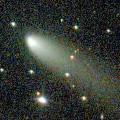
|
Now it is 12.1 mag (Nov. 1, Seiichi Yoshida). It will fade out rapidly after this. It is observable in excellent condition in the Northern Hemisphere. It stays locating extremely low in the Southern Hemisphere.
Date(TT) R.A. (2000) Decl. Delta r Elong. m1 Best Time(A, h)
Nov. 2 2 37.81 49 41.2 0.614 1.535 144 12.2 23:52 (180, 75)
Nov. 9 2 31.98 50 10.4 0.643 1.566 146 12.5 23:18 (180, 75)
|

|
Now it is 14.3 mag (Nov. 2, Chris Wyatt).
Date(TT) R.A. (2000) Decl. Delta r Elong. m1 Best Time(A, h)
Nov. 2 0 31.17 14 19.7 4.882 5.778 152 13.2 21:45 ( 0, 69)
Nov. 9 0 28.94 14 0.5 4.940 5.778 144 13.2 21:16 ( 0, 69)
|
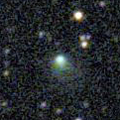
|
Now it is 13.9 mag (Oct. 26, Toshihiko Ikemura, Hirohisa Sato). It will be fading slowly after this.
Date(TT) R.A. (2000) Decl. Delta r Elong. m1 Best Time(A, h)
Nov. 2 19 34.17 -15 58.6 1.799 1.795 73 13.8 18:31 ( 29, 34)
Nov. 9 19 52.09 -15 60.0 1.852 1.794 71 13.9 18:25 ( 31, 33)
|

|
Now it is 14.2 mag (Nov. 2, Chris Wyatt). It stays 13-14 mag for a long time in 2019. In the Southern Hemisphere, it is observable in good condition. In the Northern Hemisphere, it is not observasble until summer in 2020.
Date(TT) R.A. (2000) Decl. Delta r Elong. m1 Best Time(A, h)
Nov. 2 19 3.22 -83 26.2 3.312 3.172 73 14.3 18:31 ( 4,-29)
Nov. 9 19 58.85 -80 38.3 3.367 3.191 71 14.4 18:25 ( 4,-26)
|

|
It has not been observed yet in this apparition. Now it is fainter than 21.5 mag (Aug. 4, Erwin Schwab). It was expected to brighten up to 12 mag from August to September. But actually, it must be much fainter than expected. It is observable in good condition in the Northern Hemisphere. It is not observable in the Southern Hemisphere.
Date(TT) R.A. (2000) Decl. Delta r Elong. m1 Best Time(A, h)
Nov. 2 7 31.21 56 27.1 1.070 1.686 109 14.5 4:49 (180, 69)
Nov. 9 7 36.87 57 57.0 1.069 1.731 114 15.1 4:27 (180, 67)
|

|
Now it is 16.3 mag (Nov. 2, Toshihiko Ikemura, Hirohisa Sato). It is fainter than this ephemeris recently.
Date(TT) R.A. (2000) Decl. Delta r Elong. m1 Best Time(A, h)
Nov. 2 9 18.52 9 6.1 2.593 2.608 79 14.6 4:55 (313, 55)
Nov. 9 9 24.71 8 21.2 2.531 2.640 85 14.7 5:01 (324, 58)
|
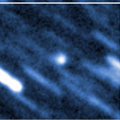
|
Now it is 14.8 mag (Oct. 30, Toshihiko Ikemura, Hirohisa Sato). It stays at 15 mag until December. It is observable in good condition in the Southern Hemisphere. It locates somewhat low in the Northern Hemisphere.
Date(TT) R.A. (2000) Decl. Delta r Elong. m1 Best Time(A, h)
Nov. 2 20 1.84 -21 16.0 1.711 1.810 79 14.7 18:31 ( 20, 31)
Nov. 9 20 16.45 -19 30.7 1.764 1.801 75 14.7 18:25 ( 23, 32)
|

|
It brightened up to 7.7 mag in June in 2018 (June 19, Juan Jose Gonzalez). Now it is fading. It has already faded down to 14.2 mag (Sept. 10, Thomas Lehmann). In the Southern Hemisphere, it stays observable for a long time until the comet will fade out. In the Northern Hemisphere, it is appearing in the morning sky, but it stays low for a while.
Date(TT) R.A. (2000) Decl. Delta r Elong. m1 Best Time(A, h)
Nov. 2 6 55.05 -33 50.2 4.875 5.140 99 14.7 4:12 ( 0, 21)
Nov. 9 6 50.72 -34 11.6 4.864 5.197 104 14.8 3:40 ( 0, 21)
|

|
Now it is 14.6 mag (Oct. 18, Chris Wyatt). In the Southern Hemisphere, it is observable for a long time. It stays low in the Northern Hemisphere.
Date(TT) R.A. (2000) Decl. Delta r Elong. m1 Best Time(A, h)
Nov. 2 22 54.05 -36 55.8 4.154 4.565 108 15.0 20:09 ( 0, 18)
Nov. 9 22 52.45 -35 30.7 4.275 4.595 102 15.1 19:40 ( 0, 20)
|

|
Now it is 15.8 mag (Oct. 31, Toshihiko Ikemura, Hirohisa Sato). It will brighten very rapidly, and it will brighten up to 14 mag in winter. It is observable in excellent condition in the Northern Hemisphere. It locates low in the Southern Hemisphere.
Date(TT) R.A. (2000) Decl. Delta r Elong. m1 Best Time(A, h)
Nov. 2 2 18.05 46 18.9 0.818 1.741 148 15.4 23:32 (180, 79)
Nov. 9 2 15.02 45 6.4 0.781 1.714 150 15.1 23:02 (180, 80)
|
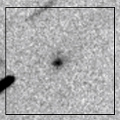
|
Now it is 15.8 mag (Nov. 1, Toshihiko Ikemura, Hirohisa Sato). The orbit is extremely hyperbolic with e=3.35. It is the first interstellar comet in history. It brightens up to 15 mag in December. In the Northern Hemisphere, it stays observable in good condition until early December. Then it will be getting lower, and it will be unobservable in mid January. In the Southern Hemisphere, it will be getting higher gradually. Then it will be observable in excellent condition.
Date(TT) R.A. (2000) Decl. Delta r Elong. m1 Best Time(A, h)
Nov. 2 10 24.85 7 15.5 2.412 2.164 63 15.8 4:55 (296, 43)
Nov. 9 10 37.32 2 55.0 2.304 2.111 66 15.6 5:01 (305, 43)
|
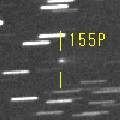
|
Now it is 15.4 mag (Nov. 1, Toshihiko Ikemura, Hirohisa Sato). It brightens rapidly, and it will be observable at 15 mag in good condition in winter. It locates somewhat low in the Southern Hemisphere.
Date(TT) R.A. (2000) Decl. Delta r Elong. m1 Best Time(A, h)
Nov. 2 9 21.50 16 25.2 1.667 1.808 81 15.9 4:55 (302, 60)
Nov. 9 9 37.90 15 37.8 1.607 1.803 84 15.7 5:01 (310, 63)
|
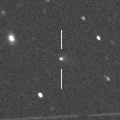
|
Now it is 15.3 mag (Oct. 25, Toshihiko Ikemura, Hirohisa Sato). It stays 15.5 mag until December, and it is observable in good condition.
Date(TT) R.A. (2000) Decl. Delta r Elong. m1 Best Time(A, h)
Nov. 2 23 42.78 -9 41.0 1.639 2.425 132 15.7 20:57 ( 0, 45)
Nov. 9 23 43.82 -9 22.7 1.689 2.410 126 15.7 20:31 ( 0, 46)
|
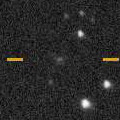
|
Now it is 15.0 mag (July 21, Taras Prystavski). It stays 16 mag for a long time from 2019 to 2020. It stays observable for a long time in the Southern Hemisphere. It is hardly observable in the Northern Hemisphere.
Date(TT) R.A. (2000) Decl. Delta r Elong. m1 Best Time(A, h)
Nov. 2 12 32.79 -71 38.7 3.847 3.453 59 15.8 4:55 (340,-28)
Nov. 9 12 46.63 -74 1.4 3.833 3.448 60 15.8 5:01 (343,-28)
|

|
Now it is 16.0 mag (Sept. 8, Roberto Haver). It is observable at 16 mag in good condition from October to November.
Date(TT) R.A. (2000) Decl. Delta r Elong. m1 Best Time(A, h)
Nov. 2 3 48.07 7 49.7 1.582 2.534 158 16.0 1:07 ( 0, 63)
Nov. 9 3 18.58 4 41.5 1.583 2.557 166 16.1 0:11 ( 0, 60)
|

|
Now it is 15.8 mag (Oct. 5, Toshihiko Ikemura, Hirohisa Sato). It stays 15-16 mag for a long time until 2021.
Date(TT) R.A. (2000) Decl. Delta r Elong. m1 Best Time(A, h)
Nov. 2 20 1.42 -24 56.3 4.940 4.839 78 16.3 18:31 ( 19, 28)
Nov. 9 20 1.24 -24 0.0 5.040 4.818 71 16.3 18:25 ( 25, 27)
|
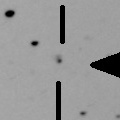
|
It looks cometary on the LCO (CTIO) image on Aug. 21. Now it is 16.2 mag (Oct. 2, ATLAS-MLO, Mauna Loa). It is observable in excellent condition in the Southern Hemisphere. In the Northern Hemisphere, it locates extremely low for a while.
Date(TT) R.A. (2000) Decl. Delta r Elong. m1 Best Time(A, h)
Nov. 2 19 46.69 -38 17.7 6.640 6.427 73 16.4 18:31 ( 18, 14)
Nov. 9 19 45.76 -37 42.3 6.760 6.430 66 16.4 18:25 ( 22, 13)
|

|
Now it is 16.2 mag (Oct. 4, Toshihiko Ikemura, Hirohisa Sato). It is expected to be observable at 5-6 mag for a long time from 2022 to 2023. In the Northern Hemisphere, it is not observable at the high light from 2022 summer to 2023 summer. In the Southern Hemisphere, it stays unobservable for a while. But it will be observable in good condition at the high light.
Date(TT) R.A. (2000) Decl. Delta r Elong. m1 Best Time(A, h)
Nov. 2 17 18.85 47 54.9 10.776 10.533 73 16.4 18:31 (125, 45)
Nov. 9 17 21.88 47 23.9 10.748 10.486 72 16.4 18:25 (125, 42)
|

|
Now it is 17.1 mag (Oct. 31, Toshihiko Ikemura, Hirohisa Sato). It will be fading after this, and it will be fainter than 18 mag in late December.
Date(TT) R.A. (2000) Decl. Delta r Elong. m1 Best Time(A, h)
Nov. 2 3 35.75 28 47.1 1.317 2.269 158 16.4 0:54 ( 0, 84)
Nov. 9 3 29.81 28 19.2 1.320 2.293 165 16.5 0:21 ( 0, 83)
|
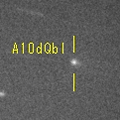
|
Now it is 16.4 mag (Oct. 30, Toshihiko Ikemura, Hirohisa Sato). It stays observable in good condition while the comet will be fading slowly after this.
Date(TT) R.A. (2000) Decl. Delta r Elong. m1 Best Time(A, h)
Nov. 2 3 25.85 -0 21.3 1.606 2.558 159 16.5 0:44 ( 0, 55)
Nov. 9 3 22.19 -1 3.6 1.649 2.606 161 16.7 0:13 ( 0, 54)
|

|
Now it is 16.7 mag (Oct. 4, Toshihiko Ikemura, Hirohisa Sato). It will brighten up to 10.5 mag from 2020 December to 2021 January. In the Northern Hemisphere, it stays observable in good condition while the comet will be brightening gradually, but it is not observable at the high light. In the Southern Hemisphere, it is not observable for a long time, but it will be observable in good condition after the high light.
Date(TT) R.A. (2000) Decl. Delta r Elong. m1 Best Time(A, h)
Nov. 2 16 42.90 66 2.2 4.793 4.800 84 16.7 18:31 (150, 40)
Nov. 9 16 49.68 64 53.8 4.730 4.737 84 16.6 18:25 (149, 39)
|
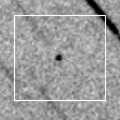
|
Now it is 16.7 mag (Aug. 9. Grorudalen Optical Observatory). It passed the perihelion on July 2. Then it must have brightened up to 13 mag, but it was not observable around that time. In the Northern Hemisphere, it stays observable in excellent condition until December when it becomes fainter than 18 mag. In the Southern Hemisphere, it stays locating low.
Date(TT) R.A. (2000) Decl. Delta r Elong. m1 Best Time(A, h)
Nov. 2 0 54.06 43 10.8 1.027 1.927 145 16.7 22:07 (180, 82)
Nov. 9 0 38.32 39 27.3 1.095 1.977 142 16.9 21:24 (180, 86)
|

|
It will brighten up to 13.5-14 mag from 2020 to 2021. It stays observable in good condition for a long time after this until 2020 summer.
Date(TT) R.A. (2000) Decl. Delta r Elong. m1 Best Time(A, h)
Nov. 2 12 3.10 14 30.1 4.330 3.707 45 16.9 4:55 (271, 28)
Nov. 9 12 10.91 13 55.6 4.238 3.689 50 16.7 5:01 (276, 32)
|

|
It stays 16-17 mag for a long time until 2020. It is observable in good condition in the Northern Hemisphere. It is hardly observable in the Southern Hemisphere.
Date(TT) R.A. (2000) Decl. Delta r Elong. m1 Best Time(A, h)
Nov. 2 12 53.33 51 57.1 8.870 8.572 69 16.9 4:55 (226, 33)
Nov. 9 12 58.55 51 47.8 8.818 8.579 72 16.9 5:01 (228, 38)
|

|
Fading. Now it is 17.3 mag (Nov. 1, Toshihiko Ikemura, Hirohisa Sato). It stays 17 mag from autumn to winter. It is observable in good condition in the Northern Hemisphere. It locates low in the Southern Hemisphere.
Date(TT) R.A. (2000) Decl. Delta r Elong. m1 Best Time(A, h)
Nov. 2 9 19.23 23 52.2 6.425 6.401 84 16.9 4:55 (290, 65)
Nov. 9 9 17.62 23 46.0 6.343 6.445 91 16.9 5:01 (304, 72)
|
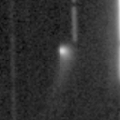
|
Now it is 17.7 mag (Oct. 31, Toshihiko Ikemura, Hirohisa Sato). It will be fading after this. In the Northern Hemisphere, it stays observable in good condition for a long time. In the Southern Hemisphere, it stays extremely low for a long time.
Date(TT) R.A. (2000) Decl. Delta r Elong. m1 Best Time(A, h)
Nov. 2 2 4.63 43 44.5 3.359 4.250 150 16.9 23:18 (180, 81)
Nov. 9 1 50.91 41 49.6 3.394 4.290 151 17.0 22:37 (180, 83)
|

|
It brighted rapidly from 20.5 mag up to 18.5 mag in September. It was 18.7 mag on Oct. 22 (Geisei Observatory). However, it was not detected, fainter than 19 mag, in late October. It will approaches to Earth down to 0.09 a.u. in early January. It will be obesrvable in excellent condition in the Northern Hemisphere. If it is as bright as in 2003, it will be 17.5 mag at best. But if it shows cometary activity, it may brighten up to 13.5 mag. In the Southern Hemisphere, it will not be observable at the high light.
Date(TT) R.A. (2000) Decl. Delta r Elong. m1 Best Time(A, h)
Nov. 2 22 24.60 -24 11.8 0.392 1.182 109 17.4 19:39 ( 0, 31)
Nov. 9 22 22.04 -23 3.2 0.368 1.129 102 17.1 19:09 ( 0, 32)
|

|
Fading now. Now it is 16.1 mag (Sept. 23, iTelescope Observatory, Siding Spring). In the Southern Hemisphere, it stays observable for a long time until it fades out. In the Northern Hemisphere, it will not be observable after this.
Date(TT) R.A. (2000) Decl. Delta r Elong. m1 Best Time(A, h)
Nov. 2 6 24.32 -49 46.5 5.071 5.289 97 17.2 3:41 ( 0, 5)
Nov. 9 6 16.64 -51 14.7 5.095 5.341 99 17.2 3:06 ( 0, 4)
|
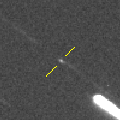
|
First return of a new periodic comet which brightened up to 18 mag in 2014. Now it is 17.2 mag (Nov. 1, Toshihiko Ikemura, Hirohisa Sato). It stays 17 mag until November. It is observable in good condition in the Northern Hemisphere. It locates extremely low in the Southern Hemisphere.
Date(TT) R.A. (2000) Decl. Delta r Elong. m1 Best Time(A, h)
Nov. 2 7 37.06 43 31.3 0.343 1.150 108 17.2 4:54 (180, 82)
Nov. 9 7 54.26 43 44.7 0.359 1.174 112 17.3 4:44 (180, 81)
|
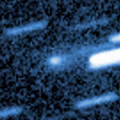
|
It brightened up to 16 mag in September. Now it is fading. Now it is 17.1 mag (Nov. 1, Toshihiko Ikemura, Hirohisa Sato). It will be fainter than 18 mag in December.
Date(TT) R.A. (2000) Decl. Delta r Elong. m1 Best Time(A, h)
Nov. 2 9 56.53 7 50.5 1.456 1.464 70 17.3 4:55 (302, 48)
Nov. 9 10 10.29 5 43.9 1.451 1.509 73 17.5 5:01 (310, 50)
|
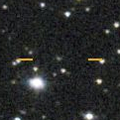
|
Now it is 17.4 mag (Oct. 4, Toshihiko Ikemura, Hirohisa Sato). It will stay at 14 mag for a long time from 2021 to 2022. In the Northern Hemisphere, it stays observable in good condition while brightening gradually, although it becomes low in December and January. In the Southern Hemisphere, it is not observable until March.
Date(TT) R.A. (2000) Decl. Delta r Elong. m1 Best Time(A, h)
Nov. 2 18 24.35 36 26.8 7.546 7.364 75 17.4 18:31 (105, 55)
Nov. 9 18 26.16 35 27.5 7.569 7.329 72 17.4 18:25 (105, 51)
|

|
Now it is 17.6 mag (Sept. 26, Toshihiko Ikemura, Hirohisa Sato). It will brighten up to 12 mag in winter in 2022.
Date(TT) R.A. (2000) Decl. Delta r Elong. m1 Best Time(A, h)
Nov. 2 22 1.77 44 40.7 7.029 7.531 117 17.5 19:16 (180, 80)
Nov. 9 22 1.38 44 6.7 7.037 7.486 113 17.5 18:49 (180, 81)
|
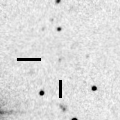
|
Now it is 17.9 mag (Oct. 8, ATLAS-MLO, Mauna Loa). It is observable at 17-18 mag for a long time from late 2019 to early 2021. It will fade out before it passes the perihelion.
Date(TT) R.A. (2000) Decl. Delta r Elong. m1 Best Time(A, h)
Nov. 2 3 17.93 0 55.5 4.251 5.201 161 17.6 0:36 ( 0, 56)
Nov. 9 3 14.29 0 45.3 4.230 5.187 163 17.5 0:05 ( 0, 56)
|

|
Now it is 18.8 mag (Sept. 27, M. Jaeger, E. Prosperi, S. Prosperi). It is fainter than this ephemeris recently.
Date(TT) R.A. (2000) Decl. Delta r Elong. m1 Best Time(A, h)
Nov. 2 2 30.86 9 47.6 3.218 4.207 175 17.6 23:45 ( 0, 65)
Nov. 9 2 26.10 9 34.2 3.241 4.221 170 17.6 23:12 ( 0, 65)
|

|
Now it is 17.7 mag (Oct. 31, Toshihiko Ikemura, Hirohisa Sato). It will be fainter than 18 mag soon.
Date(TT) R.A. (2000) Decl. Delta r Elong. m1 Best Time(A, h)
Nov. 2 23 1.83 -19 5.7 2.116 2.744 119 17.7 20:16 ( 0, 36)
Nov. 9 22 57.81 -21 14.6 2.278 2.788 110 17.9 19:45 ( 0, 34)
|

|
It approached to Earth down to 0.3 a.u. in mid February, and brightened up to 5.5 mag (Feb. 13, Juan Jose Gonzalez). Now it is fading. It has already faded down to 18.4 mag (Nov. 1, Toshihiko Ikemura, Hirohisa Sato).
Date(TT) R.A. (2000) Decl. Delta r Elong. m1 Best Time(A, h)
Nov. 2 1 55.20 39 4.0 2.771 3.691 154 17.7 23:08 (180, 86)
Nov. 9 1 39.53 37 22.2 2.849 3.762 153 17.9 22:25 (180, 88)
|
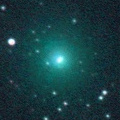
|
It brightened up to 11 mag in late 2018. Now it is 17.9 mag (Oct. 5, Toshihiko Ikemura, Hirohisa Sato). It will be fainter than 18 mag in November. It is observable in excellent condition in the Northern Hemisphere. It locates extremely low in the Southern Hemisphere.
Date(TT) R.A. (2000) Decl. Delta r Elong. m1 Best Time(A, h)
Nov. 2 3 14.57 45 30.7 3.360 4.230 147 17.8 0:33 (180, 79)
Nov. 9 3 6.48 44 20.3 3.393 4.294 152 17.9 23:53 (180, 81)
|

|
Now it is 17.8 mag (Nov. 2, Toshihiko Ikemura, Hirohisa Sato). It was exptected to brighten up to 16.5 mag from October to December. But actually, it is fainter than originally expected. It seems to brighten up to 18 mag at best. It is observable in good condition in the Northern Hemisphere. It locates low in the Southern Hemisphere.
Date(TT) R.A. (2000) Decl. Delta r Elong. m1 Best Time(A, h)
Nov. 2 8 35.70 21 31.1 1.209 1.606 93 17.9 4:55 (313, 71)
Nov. 9 8 52.75 23 38.9 1.156 1.611 96 17.9 5:01 (319, 75)
|
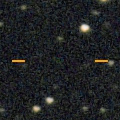
|
Now it is very faint as 19.7 mag (Oct. 25, Toshihiko Ikemura, Hirohisa Sato). It brightened up to 15.5 mag in 1997, and 17 mag in 2008, however, it is much fainter in this apparition.
Date(TT) R.A. (2000) Decl. Delta r Elong. m1 Best Time(A, h)
Nov. 2 1 11.68 16 8.0 2.381 3.339 161 20.1 22:26 ( 0, 71)
Nov. 9 1 8.87 15 21.4 2.423 3.345 154 20.2 21:56 ( 0, 70)
|
|
![]()
 78P/Gehrels 2
78P/Gehrels 2 160P/LINEAR
160P/LINEAR C/2016 M1 ( PanSTARRS )
C/2016 M1 ( PanSTARRS ) C/2017 B3 ( LINEAR )
C/2017 B3 ( LINEAR ) 114P/Wiseman-Skiff
114P/Wiseman-Skiff 2I/2019 Q4 ( Borisov )
2I/2019 Q4 ( Borisov ) 155P/Shoemaker 3
155P/Shoemaker 3 101P/Chernykh
101P/Chernykh C/2018 F4 ( PanSTARRS )
C/2018 F4 ( PanSTARRS ) C/2018 DO4 ( Lemmon )
C/2018 DO4 ( Lemmon ) C/2019 K7 ( Smith )
C/2019 K7 ( Smith ) A/2017 U7
A/2017 U7 C/2017 K2 ( PanSTARRS )
C/2017 K2 ( PanSTARRS ) 261P/Larson
261P/Larson C/2019 K5 ( Young )
C/2019 K5 ( Young ) C/2019 N1 ( ATLAS )
C/2019 N1 ( ATLAS ) (3200) Phaethon
(3200) Phaethon 246P/NEAT
246P/NEAT C/2010 U3 ( Boattini )
C/2010 U3 ( Boattini ) C/2015 O1 ( PanSTARRS )
C/2015 O1 ( PanSTARRS ) C/2018 A3 ( ATLAS )
C/2018 A3 ( ATLAS ) 289P/Blanpain
289P/Blanpain C/2016 N6 ( PanSTARRS )
C/2016 N6 ( PanSTARRS ) 384P/2019 O1 ( Kowalski )
384P/2019 O1 ( Kowalski ) 387P/2019 R1 ( Boattini )
387P/2019 R1 ( Boattini ) C/2018 U1 ( Lemmon )
C/2018 U1 ( Lemmon ) C/2019 L3 ( ATLAS )
C/2019 L3 ( ATLAS ) 173P/Mueller 5
173P/Mueller 5 65P/Gunn
65P/Gunn C/2019 K4 ( Ye )
C/2019 K4 ( Ye ) C/2018 Y1 ( Iwamoto )
C/2018 Y1 ( Iwamoto ) C/2018 L2 ( ATLAS )
C/2018 L2 ( ATLAS ) 76P/West-Kohoutek-Ikemura
76P/West-Kohoutek-Ikemura 200P/Larsen
200P/Larsen![]()







































